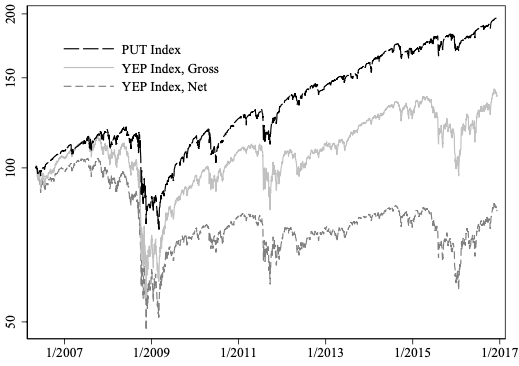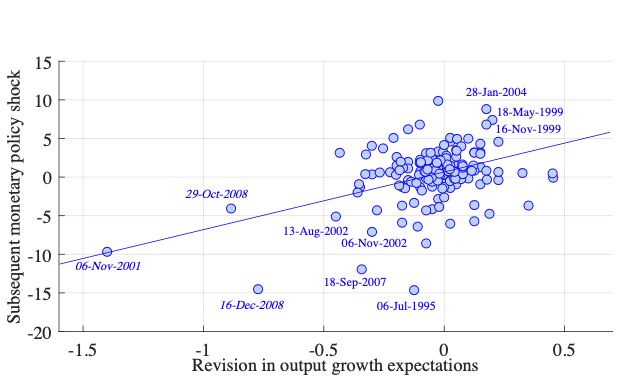Publications
Engineering Lemons
Journal of Financial Economics, Volume 142, Issue 2, November 2021, Pages 737-755.
Paper, Online Appendix, SSRN Preprint, Video, Coverage by Alpha Architect
Abstract: Recent complex financial products sold to households contradict the basic premise of canonical innovation theories: financial innovation benefits its adopters. In my 2006–2015 sample of over 28,000 yield enhancement products (YEP) the securities offer attractive yields but negative returns. The products lose money both ex ante and ex post due to their embedded fees: on average, YEPs charge 6–7% in annual fees and subsequently lose 6–7% relative to risk-adjusted benchmarks. Simple and cheap combinations of listed options often statewise dominate YEPs. Competition, disclosure, or learning do not eliminate this inferior financial innovation over my sample period.
Growth Forecasts and News About Monetary Policy
with Nina Karnaukh, Journal of Financial Economics, Volume 146, Issue 1, October 2022, Pages 55-70.
Paper, SSRN Preprint, Orthogonalized MP shocks
Abstract: We find that 30-minute changes in bond yields around scheduled Federal Open Market Committee (FOMC) announcements are predictable with the pre-FOMC Blue Chip professionals’ revisions in GDP growth forecasts. A positive pre-FOMC GDP growth revision predicts a contractionary policy news shock (positive change in bond yields), a negative GDP growth revision predicts an expansionary policy news shock (negative change in bond yields). Failing to account for this predictability biases the estimates of monetary policy effects on the economy. First, the Fed’s information effect dissipates as the truly unpredictable policy news shock does not affect professionals’ beliefs about the economy. Second, net policy shock has a more negative impact on actual future GDP than the raw policy shock.
Working Papers
Democratizing Private Markets: Private Equity Performance of Individual Investors
with Cynthia Balloch, Federico Mainardi, and Simon Oh
June 2025 | SSRN Working Paper, Slides | Coverage by SEC Commissioner Uyeda
Abstract: Using new data on wealthy U.S. households, we provide the first systematic study of private equity performance by individual investors. We identify two innovations that democratize access to private equity: the proliferation of funds with low minimum commitments and pooling capital via advisors. Contrary to concerns about poor performance, we find that aggregate individual investments in private equity perform similarly to institutions and outperform public markets. In the cross-section, the most affluent investors outperform the less affluent by 6 to 10 percentage points in public market equivalent. We show that advisor skill is more likely to explain the performance gap rather than preferential access. Using both observed and simulated intermediary fees, we show that fees impose a sizable drag on performance, especially for less affluent investors.
Conferences: Western Finance Association; RCFS Winter Conference; Columbia PE Conference; Aalto Institutional Investor Conference (Helsinki); IPC Alternative Investments Conference & Spring Research Symposium 2025; 12th Annual Conference on Financial Market Regulation (SEC); Private Capital Symposium (LBS); UT Dallas Finance Conference; Finance, Organizations and Markets Conference (USC); 2025 Private Firm Symposium (U Chicago)
Labor income response relative to year before joining
Household Responses to Phantom Riches
with Samuli Knüpfer, Ville Rantala, and Erkki Vihriälä, Revise and Resubmit at Review of Financial Studies
November 2024 | SSRN Working Paper
Abstract: We study the consequences of investment fraud victimization using unique administrative data on Ponzi scheme investors. A matched control event-study design shows that the victims experience a 6% annual labor income loss. Income first declines when an investor joins the scheme, consistent with distorted beliefs lowering labor supply. The scheme’s collapse triggers a further decrease, which we attribute to financial stress caused by the collapse. Investors also face higher indebtedness and tilt their portfolios away from delegated investments. The income loss persists in the long run, equals twice the direct investment loss, and substantially adds to the social cost of fraud.
Conferences: EFA, CEPR European Conference on Household Finance (Turin), Virtual Household Finance Seminar, NFA
Juicing the Coupon Yield: How Banks Extract Rents from Behavioral Biases
July 2025 | SSRN Working Paper
Abstract: The fees on yield enhancement products increase strongly with coupons, despite minimal pass-through of coupons to returns. As a result, higher coupons paradoxically lead to lower net expected returns. Demand estimates exploiting pricing shocks show investors pay over 35 basis points for one percentage point of coupon. Banks engineer coupons using exotic, hard-to-value options that artificially increase coupons, but much less so returns. These patterns are inconsistent with standard reaching-for-yield models and instead point to investor inattention to shrouded attributes. I show that the resulting rents extracted by banks are several times larger than those documented in other financial markets.
NFA 2023 Best Paper Award in Asset Pricing and Market Microstructure
Conferences: AFA (San Antonio), NBER Behavioral Finance, CEPR Workshop on Household Finance, Finance Down Under, Virtual Derivatives Workshop, HEC-McGill Winter Finance Workshop, SGF, MFA, WAPFIN @ NYU, CFPB Research Conference, NFA, CDI
Household share in cross-sectional volatility
DO HOUSEHOLDS MATTER FOR ASSET PRICES?
with Carter Davis, Samuli Knüpfer, Jens Soerlie Kvaerner, Bahar Sen-Dogan
March 2025 | SSRN Working Paper | Slides
Abstract: Contrary to the common assertion that households have little impact on stock prices, we find their importance is of first order. We quantify their impact using an asset-demand system applied to the complete ownership data for all Norwegian stocks over 2007--2020. Households are the most important contributor to stock market volatility relative to their market share. Even in absolute terms, they come second, surpassed only by institutional investors. Our granular data on households reveal a strong factor structure in household demand: The demand of the rich is distinct from less affluent investors, accounts for the bulk of volatility attributable to households, tilts away from ESG, and is informative about future fundamentals. We conclude by quantifying key frictions preventing other market players from absorbing household demand shocks.
Conferences: CEPR European Conference on Household Finance (Stockholm), European Finance Association, Midwest Finance Association, Northern Finance Association
Work IN Progress
BELIEFS, REFERENCE POINTS, and The disposition Effect: Evidence from Option Traders
with Aleksi Pitkäjärvi and Matteo Vacca
Abstract: We use over 15 years of microdata on Finnish option traders to test competing explanations for the disposition effect. By isolating situations where an investor simultaneously holds multiple options on the same underlying asset, we show that the disposition effect arises even when beliefs about expected underlying returns are fixed. Consistent with strike prices acting as target-driven reference points, we document a discontinuity in selling propensities at the strike price and significant bunching of sales on the day when the price of the underlying crosses the strike for the first time. These patterns are not driven by rational rebalancing or transaction costs, are inconsistent with pure belief-based explanations, and provide new support for reference-dependent preferences.







